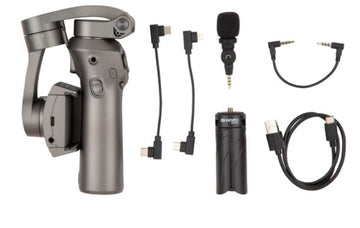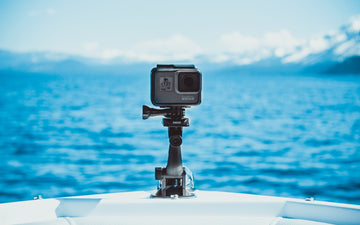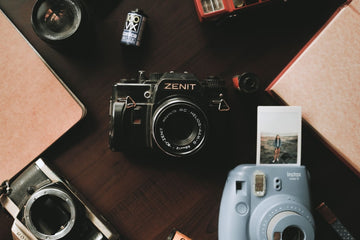Mastering Stabilization for Perfect Shots with Gimbals!
May 29, 2023

"Photography is the story I fail to put into words." - Destin Sparks.
The art of capturing spectacular moments for visual storytelling calls for stability and accuracy. Gimbals play a key role in this, transforming photography and filmmaking. We will delve into the world of gimbals in this blog, learning what they are, how they function, and how to master their use to capture spectacular camera pictures. Whether you're a seasoned filmmaker or a budding photographer, this guide will teach you the tricks for gimbal stabilization and reveal the best ways to capture candid moments.
Understanding Gimbals: A Revolution in Camera Stabilization:
Gimbals are basic tools used to stop unintentional camera movements. They offer stability and enable seamless movements, minimizing shaky footage and making it simple for photographers and filmmakers to easily capture breathtaking images. Gimbals maintain the camera's position and balance outside pressures by utilizing a mix of motors and sensors, producing smooth, stabilized pictures.
The Benefits of Using a Gimbal for Camera Stabilization:
The use of gimbals has revolutionized the fields of photography and filmmaking. Here are some key benefits of gimbals:
- Enhanced Stability: Gimbals eliminate vibrations and jerky movements, ensuring professional-quality footage even in challenging shooting conditions.
- Creative Freedom: With a gimbal, photographers and filmmakers can explore various camera movements, such as panning, tilting, and tracking shots, opening new avenues for artistic expression.
- Versatility: Gimbals are compatible with various camera setups, from lightweight mirrorless cameras to heavy-duty cinema cameras, making them accessible to professionals and enthusiasts alike.
- Time Efficiency: Gimbals allow for quicker setups and faster production workflows by providing stability and eliminating complex rigging setups.
Mastering the Art of Gimbal Use: A Step-by-Step Guide:
To maximize your gimbal's potential, follow these essential steps:
- Choosing the Right Gimbal for Your Camera Setup: Consider factors like payload capacity, compatibility with your camera model, and additional features such as follow focus or remote-control options.
- Balancing Your Camera on the Gimbal: Proper balancing is crucial for optimal performance. Follow the manufacturer's guidelines and ensure your camera is evenly distributed across the gimbal's axes.
- Grip and Handling Techniques for Smooth Movements: Hold the gimbal securely with both hands, distributing the weight evenly. Practice gentle and precise movements to achieve smooth camera motions.
- Utilizing Different Shooting Modes and Creative Techniques: Experiment with various shooting modes, such as follow mode, locked mode, or pan follow mode, to suit your specific shots. Explore creative techniques like low-angle shots, high-angle shots, or dolly zoom to add depth and visual interest to your footage.
Gimbal Bearings: The Unsung Heroes of Smooth Camera Movements:
For the stability and fluidity of camera motions to be maintained, gimbal bearings are essential. These tiny, precisely manufactured parts make rotation along several axes possible. Gimbal bearings, however, could degrade over time due to heavy use or outside influences. Increased friction, jerky movements, or clicking noises are indications of a worn-out Gimbal bearing.

How Often Should a Gimbal Bearing Be Replaced?
The need for gimbal bearing replacement relies on several variables, including the bearing's quality, the environment it is used in, and how frequently it is used. For optimum performance, inspecting and maybe replacing gimbal bearings every 6 to 12 months is advised. It is advisable to change the bearing as soon as you notice any of the signs mentioned above of wear to avoid endangering the stability of your shots.
Maintaining and Caring for Gimbal Bearings:
To extend the lifespan of your gimbal bearings, consider the following maintenance tips:
- Regular Cleaning: Remove dust or debris accumulating on the bearings using a soft brush or compressed air.
- Lubrication: Apply a small amount of high-quality lubricant recommended by the gimbal manufacturer to ensure smooth operation and minimize friction.
- Avoiding Extreme Conditions: Protect your gimbal from excessive moisture, extreme temperatures, and sudden impacts to prevent premature bearing wear.
Overcoming Common Challenges in Gimbal Operation:
While gimbals are powerful tools, they come with their own set of challenges. Here are some common issues you may encounter and tips to overcome them:
- Balance and Weight Distribution: Ensure proper camera balance by adjusting the gimbal's axes and redistributing weight if necessary.
- Battery Life and Power Management: Carry spare batteries and utilize power-saving features to extend your gimbal's runtime during long shoots.
- Limitations in Movement and Framing: Familiarize yourself with the limitations of your gimbal's range of motion and plan shots accordingly to avoid unintentional camera movements or obstructed views.
- Troubleshooting Common Technical Glitches: Stay updated with the latest firmware and consult the gimbal's user manual or online resources for troubleshooting tips related to specific issues.
Elevate Your Gimbal Game: Advanced Tips and Techniques:
Take your skills to the next level with these advanced tips:
- Mastering Tracking Shots and Dynamic Movements: Practice using your gimbal to follow objects or subjects smoothly while preserving your frame and point of focus.
- Creating Cinematic Sequences with Creative Camera Angles: Experiment with unique camera angles, such as low-angle or high-angle shots, to add visual interest and depth to your footage.
- Incorporating Specialized Accessories for Enhanced Functionality: For more flexibility and creative options, consider adding extras like external monitors, wireless follow-focus devices, or smartphone apps.
- Pushing the Boundaries with Time-lapse and Hyperlapse Techniques: Utilize your gimbal's time-lapse and hyperlapse capabilities to capture mesmerizing footage of changing environments or dramatic transitions.
Conclusion
We hope you've learned a lot about the technique for employing gimbal stabilization to produce professional-caliber camera photos as we end this in-depth guide to the subject. Every artist has their style to illustrate their story, and gimbals are the brush they use to create it. Explore a variety of gimbals and camera accessories at avcstore.com to get started on your path to compelling visual storytelling.
"Every artist dips his brush in his own soul and paints his own nature into his pictures." - Henry Ward Beecher.
Frequently Asked Questions (FAQs).
Q: How does a gimbal differ from image stabilization in lenses?
A: While lens stabilization compensates for slight camera movements, gimbals provide comprehensive stabilization on multiple axes, offering greater control and versatility.
Q: Can gimbals be used with smartphones and action cameras?
A: Absolutely! Gimbals are available in various sizes and designs, catering to smartphones, action cameras, and professional DSLRs.
Q: Are gimbals waterproof and suitable for outdoor shoots?
A: Some gimbals are water-resistant, making them suitable for outdoor shoots. However, checking each gimbal's specifications for specific waterproof capabilities is essential.
Q: Can gimbals be used for professional videography and filmmaking?
A: Absolutely! Many professional filmmakers and videographers rely on gimbals for their versatility, stability, and ability to capture smooth and dynamic shots.





